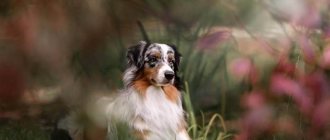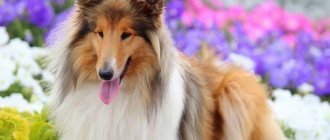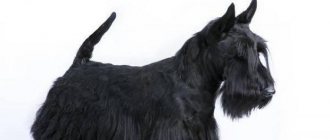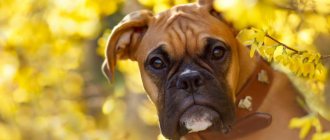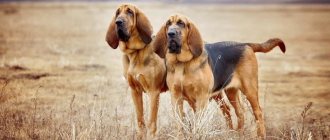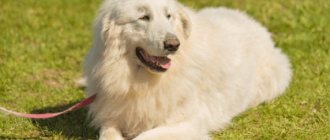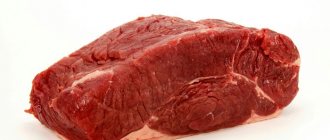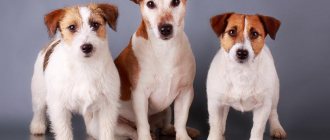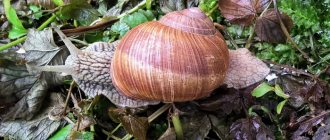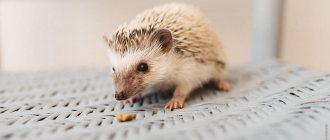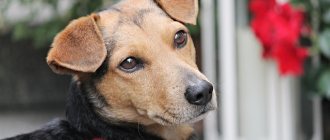Ca-de-bo or Major Mastiffs are powerful short-haired dogs with a massive head and a wide cone-like muzzle. Due to their high performance and physical strength, in ancient times they were used to protect the owner's property, hunt big game, drive livestock and protect bullfighters from bull horns. And although many of these functions are no longer relevant, Major Mastiffs still live next to people. Let's find out what a cadebo is and what the specifics of keeping the breed are.
Description of the Ca-de-Beau breed
Popularity 21st among 263 dog breeds
Lifespan:
10-12 years
Height:
males: 55-58 cm, females: 52-55 cm
Country of origin:
Spain
Average price:
25-35 thousand rubles
Weight:
from 30 to 38 kg
Latest articles Cat health
Ataxia in cats: what it is, how it manifests itself and is treated 01/23/2022 169 0 0
Cat health
Leukemia, or viral leukemia in cats 01/23/2022 151 0 0
Advantages and disadvantages
- Pros:
- good security qualities;
- phlegm;
- low shedding and easy care;
- peacefulness;
- calm attitude towards children and other animals;
- affection for all family members.
- Minuses:
- dominant character;
- a small number of nurseries where you can buy a purebred puppy;
- high physical activity requiring walking;
- high cost of maintenance.
Key facts
The name of the breed Major Mastiff, also known as ca-de-bo, hints that the country of origin of these friendly giants is Spain, namely the island of Mallorca. Ca-de-bo means "bull dog".
The description of the Ca de Bou breed emphasizes that the large size of the dog does not allow it to be kept in a small apartment - the best solution would be a country house.
The external characteristics of the Ca-de-Beau, or Major Mastiff, breed are as follows:
- The height of males can reach 60 cm, weight - 40 kg, while females are slightly smaller;
- the breed is popular on the Eurasian mainland, but is almost unknown in America and Australia;
- Despite their “fighting” past, mastiffs have a friendly character and are not overly aggressive;
- The life expectancy of the Ca-de-Beau is 10-12 years, which is considered sufficient for large dogs.
With proper care, a dog can live up to 15 years, but then its health must be carefully monitored. The dog does not cause unnecessary problems if it is carefully trained at a young age. But a spoiled ca-de-bo can become uncontrollable and even aggressive.
The history of the origin of ca-de-bo
Perro Dogo Mallorquin can be called a “dark horse”. The history of dogs of this breed, which began in the middle of the thirteenth century, is accompanied by a trail of their own blood, high mortality of weak puppies and even adult fighting dogs.
It is assumed that the first Molossians (the ancestors of the group of modern mastiffs) appeared on the island of Majorca in the Balearic archipelago due to uncontrolled matings of local dogs. At first, dogs of this breed helped people with cattle driving. Then the villagers noticed the good protective qualities of the animal, making it a guard of houses and numerous maritime warehouses.
Aristocrats liked the appearance of the Ca-de-Beau ancestors, brute strength, good endurance - all these qualities made it possible to use animals during hunting. Boars, bears, and large game were frequent trophies for future Major Mastiffs.
The eighteenth century began with the signing of the Treaty of Utrecht, which stated that Majorca passed into the possession of Great Britain. The cruelty of the English combined with the Spanish thirst for spectacle, and thanks to this, new types of leisure appeared: dog fighting and bullfighting, during which a man went out without a weapon, accompanied by a dog. But the demand for the latter type of “leisure” quickly subsided, since the Perro Dogo Majorquins either killed the bull in the first minutes of the spectacle, or died defending the owner.
The Spaniards were not happy with this state of affairs. A tough selection began: no one cared for weak puppies - they died; people did not vaccinate the Molossians and did not monitor their diet. The bitch who gave birth to them was responsible for raising and feeding them, provided that she survived. Aggressive, cowardly puppies also died from the teeth of their brothers. The continuation of brutal fighting also claimed the lives of dogs: cripples were killed.
The strongest surviving puppies grew into proud, medium-sized dogs that gave birth to healthy offspring. In 1923, the Major Molosser was entered into the Spanish studbook as a Ca-de-Bo. The first representative of the breed was exhibited in 1929.
In difficult times of war, mastiffs remembered their military past, helping soldiers and killing enemy animals. In general, the population did not suffer as much as during indiscriminate bullfighting and hunting.
In 1964, the International Canine Federation created a standard for Major Bulldogs - this happened quite late compared to other breeds. Even after final registration, the dogs were not as popular as German shepherds, Great Danes, and Rottweilers.
Perro dogo Mallorquins received due attention towards the end of the 20th century. Russians and Poles became especially interested in dogs of this breed, while other European and Scandinavian countries showed no attention to them at all; The breed is still not popular in the USA and Canada.
Origin
Representatives of the breed were formed on the Balearic Islands, which belong to Spain in the Mediterranean Sea. The Mastiff is also called Major because it is named after the famous island. Today dogs are popular in many countries, but the Spaniards especially love them, considering them a national treasure.
The exact origin of the dog remains unknown today. Cynologists argue about which breeds participated in the creation of the Ca-de-Beau. The following versions exist :
- In the seventeenth century, the fighting and Spanish guard dog was crossed with the Iberian mastiff. The representative of the latter breed gave the puppies courage, fighting qualities and power.
- In the twelfth century, Canary dogs, brought to the Balearic Islands and famous for their watchdog, guarding and herding qualities, were crossed with Alans, Spanish watchdogs. Subsequently, shepherd dogs from Mallorca were crossed with bulldogs.
- In the seventeenth century, the Old English Bulldog was crossed with Spanish Mastiffs and Bulldogs, resulting in the Ca-de-Bo.
The dog received official recognition at the beginning of the twentieth century, as it began to be recorded in stud books at this time. The first exhibition where dogs were included was in Barcelona, and this one also contributed to the recognition of animals. During the Second World War, the pets almost disappeared completely, and they were restored in the 80s. this century.
Similar dog breeds
Rottweiler
Cane Corso
Newfoundland
Alaskan Malamute
Tibetan mastiff
Appearance of the ca-de-bo
The purpose of the ca-de-bo is considered to be protection, but the animal can become a devoted pet if properly raised. External strength goes well with a kind and loyal character.
General impression
What does the ca-de-bou look like in photos and in life? The dog is slender and fit, but looks quite massive. The weight and height are average, but the dog looks proportional.
Head
The animal's head resembles a square, characterized by massiveness. The cone-shaped muzzle can be called upturned. The stop is well defined. The high-set, medium-sized ears resemble a rose; when the animal is calm, they are lowered to the line of large, oval, slanting eyes.
The color of the eyes depends on the color of the dog and allows a mixture with darker shades than the coat. The protein is invisible.
The black nose is characterized by well-opened nostrils. The upper lip is tense, while the lower lip is in a relaxed position. The teeth are strong, with an overshot of up to 1 cm.
Neck
The massive neck, well set at the withers, may have a medium dewlap.
Torso
The narrowness of the loin results in a croup that is more square than round. The chest is cylindrical and deep - it reaches the elbows. Widely spaced shoulder blades make the chest visually wider at the withers. The body is muscular and athletic.
Forelegs
The front legs appear parallel. The shoulder joint is moderately short and slightly prominent. One shoulder is parallel to the other. The elbow is loosely attached to the chest, not turned out. The forearm is straight.
The bones are strong, the limbs look muscular. The paws are rounded, the toes form a lump. The pigmentation of the pads and claws is weak.
Hind limbs
The hind legs are parallel. The thigh is wide and curved. The straight hock joint is short. The muscles are more developed than on the forelimbs. The oval legs are more massive than the forelegs. Pads and claws are poorly pigmented.
Tail
The low-set tail is thin at the tip but widens towards the base. A calm dog keeps his tail relaxed; an excited or moving dog lifts it slightly.
Movement
It is typical for the Major Mastiff to trot. The movements are sharp and proud.
Wool
The wool is pleasant to the touch. The hairs are short, tightly adjacent to each other.
Color
The most advantageous color for Ca-de-Beau to participate in exhibitions is considered to be deep red (brindle, fawn), but black is also allowed. White spots on the face, chest and limbs are allowed. The presence of a mask on the face is not a disqualifying defect.
Size
The Perro Dogo Mallorquin puppy is born small, but by the month it gains up to a kilogram in weight. The height and weight of Ca-de-Beau in adulthood depends on the conditions in which the dog grew up, the quality of food and gender - boys are heavier than girls.
The height at the withers, that is, the height of the ca-de-bo reaches 55-58 cm in a male, weight is 35-38 kg; the female grows to 52-55 cm and weighs from 30 to 34 kg. A slight increase in weight is allowed while maintaining a harmonious appearance. The size of the ca-de-bout is not a priority when evaluating judges; the main condition is proportionality.
Distinctive features
We can say that these dogs look like typical mastiffs, but are somewhat similar to bulldogs. They have a wide muscular body, strong bones, and pronounced skin folds. They can be classified as large dogs, the average height at the withers is 52-58 cm. Despite this, the animals are quite light, 35-40 kg.
- The head is square, large (in males it is larger, more voluminous), the skull is flat, the frontal groove, occipital and frontal vaults, and stop are clearly visible.
- The muzzle is of medium length (equal to the skull), wide, square, tapered towards the nose. The jaws are closed tightly, which provides a good grip. Overbite type. Skin folds are not a defect and are prescribed by the standard. The lips are fleshy, slightly jagged.
- The nose is large and black .
- The eyes are set deep and wide. Slanting, medium-sized, almond-shaped. The iris is brown, mostly dark.
- The ears are rose-shaped, hanging on hard, wide cartilage, and medium in length.
- The body is rectangular, streamlined, muscular. The topline is slightly arched, the loin is wide, the croup is sloping. The neck is short and wide. The chest is voluminous: well dropped to the middle of the elbow.
- The tail is thick at the base, set below the croup line, and when active does not rise above the loin.
- The limbs are strong and of medium length. Hips are powerful and voluminous. Both front and rear are parallel and straight. The feet are round, with large toes and claws.
- The coat is short, close-lying, with good undercoat. Colors: brindle, black, tan, maybe black mask.
Character of the ca-de-bo
Under the thick skin with pleasant, but slightly prickly fur, hides a kind and sensitive heart. The character of the Ca-de-Beau next to a skilled owner-trainer is flexible; by nature, dogs are phlegmatic. Aggression, attributed to an animal because of its appearance, can manifest itself in the event of unsuccessful socialization by the puppy at home or lack of upbringing.
They tolerate forced loneliness calmly - you won’t find any wild barking, no howling, or tattered furniture upon your return. The Major Mastiff cannot be called an overly active dog: he does not like long walks on the street. But being in a good mood and accompanying its owner, the animal can happily walk for many kilometers both in winter and in summer.
Who is the Major Mastiff suitable for? Due to its excessive tendency to dominate, the mastiff is not suitable for inexperienced and too soft dog breeders - this is perhaps the only limitation. Ca-de-bos are owned by young families and retirees who are able to take care of a dog in strong hands.
As soon as he finds himself in a new house or apartment, the dog wins the attention of each family member and gives them equal portions of affection. Perro dogo Mallorquin loves to play with children, gets along easily with other animals and rarely shows displeasure towards them.
If you get a dog of this breed, get ready for the fact that your life will change in a positive direction: the familiar world will take on bright colors.
Kadebo - character and behavior
Ka-de-bo are calm, mentally stable dogs that are very difficult to unbalance. They quickly become attached to people and treat all household members with equal love, without prioritizing.
Major Mastiffs easily adapt to changes in environment and do not require much attention. They are not prone to idleness and damage to the owner’s property, so you can safely leave them behind when going to work.
Outwardly phlegmatic and unfussy, ca-de-bos can be obstinate. Moreover, periods of dog stubbornness usually coincide with adolescence and sexual heat.
Ca-de-bos have developed protective qualities and are distrustful of strangers. In case of danger, Major Mastiffs will rush to protect household members and their property without hesitation, turning from a phlegmatic pet into a ferocious beast in seconds. Dogs calmly accept their owners' guests, but if the owners are not at home, they will not let in even people they know well.
Breed and children
Ca-de-bos easily get along with children and are patient with their pranks. Dogs allow babies to do whatever they want with them and willingly play with them. True, communication between Major Mastiffs and children should be under the supervision of adult family members, so that heavy pets do not accidentally knock down children.
Breed and other animals
Ca-de-bos are loyal to other pets and do not get into fights with their relatives. True, if the matter concerns the division of territory between the Major Mastiff and his same-sex brother, then everything may end in a brawl.
Cats, birds and rodents do not arouse either aggression or desire to hunt in Ca-de-Beau. Therefore, small animals can be safely kept in the house where the Major Mastiff lives.
Education and training
The Major Mastiff, despite its phlegmatic character, needs a responsible owner who can create competent training programs. But not everything depends on the owner: primary socialization takes place in the nursery where the puppy was born, so it is important to be confident in the integrity of the breeder.
Raising and training Ca-de-Bo should begin at two months, in particular, from the moment when the animal first finds itself in a new home. It is important to show the puppy the internal “hierarchy” and the boundaries of what is permitted.
It wouldn’t hurt to communicate with older, well-mannered and trained four-legged friends. Training should become more difficult in proportion to the age of the animal. Carefully practice the desired habits, since they can be easily corrected only in the first year of the animal’s life - during the most active period of brain development.
The little Great Dane often rebels, testing the owner's strength: he chews furniture, goes to the toilet on the carpet, or does something similar. Owners, frightened by such behavior, take the animal to a dog handler. But everything is simpler: the animal simply tests the owner’s endurance.
It is recommended to take the obstinate dog to group classes, where he can meet more well-mannered dogs and learn the basics of good behavior. The ideal solution would be to attend OKD or UGS courses.
Looking for a ca-de-bo? Find your pet from 1 offer Buy
Clothes for cadebo
Since these dogs are short-haired, they need warm clothes for walking in cold weather. For example, a Major Mastiff in winter can be dressed in waterproof overalls or a jacket with double padding polyester insulation. Your pet will look fashionable and stylish in a sheepskin coat made of modern soft, breathable Polartek fabric. For warm but damp weather, a lightweight, unlined raincoat is ideal. Some owners prefer to dress cadebos in custom-made sleeveless vests. It should be remembered that all dog clothes should be comfortable to wear and durable.
Health and illness Ca-de-Beau
Due to the low survival rate of weak individuals in the past, modern Major Mastiffs are very healthy, and the number of genetic diseases characteristic of them is small. Vaccinations against serious diseases are given to puppies while still in the kennel, but every year the protection should be updated by revaccination.
An active lifestyle and good nutrition are important to prevent obesity. It is necessary to carry out daily toileting (especially during the molting period, because the animal may begin to itch severely due to itching from crawling fur, which will be especially noticeable on the face), monitor the condition of the oral cavity and brush its teeth at least twice a month - to prevent the appearance of tartar.
Possible diseases
Mostly, dogs from Mallorca have problems with the gastrointestinal tract, musculoskeletal or cardiovascular systems:
- allergies to food (individual intolerance to any element manifests itself as a rash on the skin, redness of the eyes, and unpleasant odor from the ears);
- hepatopathy is a general name for a number of liver diseases;
- myositis - the disease is an inflammation of the muscles;
- hip dysplasia.
Due to stress, dermatitis, other diseases of the skin and coat, and stomach problems can occur. Most ailments can be treated if you visit a veterinary clinic in a timely manner.
Reproductive health
Pregnancy and childbirth of the Major Mastiff proceed safely if several rules are followed. Firstly, mating cannot be carried out during the first heat, when the bitch’s body has not yet fully formed. Secondly, it is necessary to provide the animal with everything necessary - medical care, good nutrition, a favorable atmosphere to prevent the development of stress. Thirdly, care should be taken to create good conditions for future offspring, because after birth, puppies must live in the breeder’s house for some time.
If the dog owner is not sure that he will be able to bear the corresponding costs, the dog can be sterilized. The life of the owner and the bitch will be simplified significantly - there is no need to worry about dirty furniture and unwanted matings during escapes.
Features of feeding and diet
Ca-de-bo nutrition is a frequently discussed issue on forums. If the owner does not have the opportunity to visit a doctor or consult a canine specialist, then you can read the guide on feeding a puppy or an adult dog written about this breed.
The basis of the diet can be natural food or dry food. In any case, the norms for the intake of proteins, fats, carbohydrates and calories must be observed, and the health characteristics of the animal must also be taken into account.
The number of feedings and the size of portions depend on the age of the individual. A one-month-old puppy should receive small handfuls of food six times a day, a five-month-old baby should receive three small portions, and an adult dog should receive two fairly large portions.
Natural nutrition is the most difficult to “execute” due to the need to constantly monitor the quantity and quality of nutrients entering the body. On this type of diet, the mastiff can be given the following food groups (mainly of animal origin):
- lean red meat;
- poultry meat (chicken, turkey);
- rabbit meat;
- offal;
- low-fat sea fish, boneless;
- fruits, berries (except for fruits with seeds and citrus fruits);
- vegetables (peas, cabbage, beans are excluded);
- vegetable oils;
- fermented milk products with a low fat content;
- whole grain crops.
The dry type of food involves feeding one type of food (necessarily premium, since cheaper analogues often contain substances harmful to the dog).
The owner decides what food to feed the dog: after moving to a new home, for one month the puppy eats the same food as in the kennel, and then the owner can change it. It is important to choose the right food so that it covers the dog’s energy costs and maintains its appearance in proper condition. If the animal has undergone medical intervention or acquired a chronic disease, the veterinarian selects food adapted to the new needs of the body.
What to feed your pet?
Dogs are fed according to certain patterns, and they differ for adults and puppies.
Puppy
It is especially important to feed your puppy properly in the first year of life. This will determine how he grows up. After all, it is during this period that bones, fur, and olfactory organs are formed. The feeding schedule is standard, but the owner can make adjustments due to external conditions and the needs of the animal itself.
It is recommended to feed puppies on the following schedule:
- up to 2 months – 6 times a day;
- from 2 months the portions are larger, but meals are taken 5 times a day;
- From 4 months they feed 4 times a day. The portions are increased again; from six months they feed 3 times a day;
- from 1 year of age they feed in the morning and evening, but make sure that the dog eats enough.
Overfeeding is also unacceptable. Uneaten food should not be left within the puppy's reach. Only the container with water should remain standing at all times.
Meat and meat products are natural food for puppies. Raw meat can be given once a week, and only absolutely fresh. Pork is not recommended for consumption. Raw sea fish is also introduced once a week. Fish and meat are fed in the form of pieces. Within reasonable limits, bones scalded with boiling water, raw eggs, and milk are given. Dogs should eat raw vegetables and fruits. This keeps your teeth in good condition. Sweets and flour baked goods are contraindicated. To fully replenish the animal’s body with all the necessary minerals and trace elements, fish oil, ground eggshells, white chalk, pharmaceutical sulfur, and brewer’s yeast are introduced. The temperature of the food should be comfortable and should not be hot or ice cold, straight from the freezer.
Adult dog
Practice shows that feeding pets occurs in 3 types:
- concentrated special feeds;
- the dog is specially prepared;
- They are fed with what is left from the master's table.
The first two feeding methods are acceptable. The latter is highly not recommended; the dog will not benefit from it. There are no problems with special feeds; they are all balanced. The owner knows the appetites of his pet and gives him exactly as much as required. A prerequisite for such feeding: fresh water is within reach around the clock.
When feeding at home, the diet is the same as for puppies, but in larger doses. It is advisable to feed adult dogs with thin porridges or thick soups from the products listed above. The preferred grains for dogs are pearl barley and barley. Potatoes are added in moderation.
Care and maintenance
Care and maintenance of a ca-de-bo implies the presence of either a large apartment or a country house - due to the large size of the animal. The minimum necessary for a comfortable stay will be a large warm bed in a well-ventilated but not cold place, a small number of toys, freely available food and water.
The Mastiff does not need to be entertained intensely - its character allows you to leave the animal alone for a long period of time without dire consequences for the home. Only competition animals need grooming, but if the owner wishes, any animal can be groomed by a professional.
How to care for a dog of this breed? Major dogs are not a long-haired breed, so caring for them can be called simple. The coat does not need daily brushing (except during shedding periods). It is recommended to carry out thorough washing no more than twice a month, so as not to wash off the natural protective layer from the hairs.
Claws are trimmed in winter, when the animal does not have the opportunity to grind them off on the asphalt on its own. Due to the pink-like shape of the ears, they should be treated quite often - this will help protect your pet from parasites.
A separate topic is oral care - brushing your teeth should become a weekly ritual, which will prevent the appearance of caries and tartar. Plaque in representatives of this breed occurs quite often due to the structural features of the jaw.
Owner reviews
Kate
Our family is the happy owner of a Ca de Bou dog. Our pet Argo has been living with us for 4 years now. Despite her small size for a large dog, she feels great in our apartment. This is a very kind animal that always treats children with affection. As soon as a child starts crying, the first person who rushes to his aid is our pet. Argo is very easy to care for with his short coat. He is not picky about food and enjoys eating porridge with meat. After a walk, you don’t have to force him into the bath to wash his paws off the dirt. We have never seen any signs of aggression from him; our pet is even friendly towards strangers.
Irina
Kadebo is an ideal dog for a city dweller who is always busy and a little lazy: it does not require long walks. She is comfortable in a country house. Doesn't take up much space, gets along great with children. Not slobbering.
Peter
I had two other breeds before Ca de Bou, but now I understand that after Ca de Bou I will only have Ca de Bou. This breed has only one drawback: it penetrates the soul and fills it.
Lisa
When I found out about this breed, I didn’t find a single negative review about it, so I decided to get this particular dog. But to please our daughter, who dreamed of an Amstafa, we chose a black Ca de Bou, which slightly resembles an Amstafa. My daughter liked my decision. It’s already been 5 months since this girl has been living in our apartment, and my daughter already treats her differently. If we want to get another dog, it will definitely be a Kadeboshka. Dami has become a new member of our family whom we love very much. This is an excellent option for an apartment, because it is small in size, very obedient and incredibly loyal.
Alexei
My Largo is a godsend for an apartment, because with its large size, it is almost invisible at home. In his free time he just lies quietly on the sofa, sleeping. But when someone comes, it’s just a hurricane of joy and happiness. The breed has several disadvantages: it sheds, and short hair is difficult to remove from things. Also, great stubbornness; if you decide to chew on a table or a corner of a wall, you will chew no matter what you do. And lastly, Largo cannot have a large list of products, because the breed is very allergic. There is only special food, very expensive. Otherwise, he is a wonderful dog, not evil, but his appearance inspires respect, the neighbors are afraid to ride in the elevator with us. On the street, Largo is accustomed to walking next to him, since holding almost fifty kilograms is not easy even for me!
Oleg
A Ca de Bou girl named Nessie has been living with us for a year and a half. She is very, very active, loves to misbehave and rush around the playground with other dogs. Peace-loving and gentle, absolutely not aggressive towards children. But when they came to install a sink, she rushed at the plumber, although she had never shown watchdog skills before. At the training ground he does almost all the commands, but only if he has a good run before the lesson. The level of activity on the street is simply enormous, although at home he usually behaves very quietly, mostly sleeping. At the exhibition, however, she showed herself excellently, won the title “Best Junior” and even won best!
Leonid
This dog came to us recently - only 2 months ago. We took him in as an adult puppy, when he was 6 months old, but we still found a common language with him. I would like to express special gratitude to the breeder who taught him the basic commands. But we continue to train him ourselves. We are literally amazed at how quickly she picks things up. She especially likes to play. We often go somewhere with her to play ball and try to catch up with each other. At such moments, the dog looks especially happy, it seems that a smile appears on his face. At the same time, it is an excellent guard. He reacts perfectly to any person who walks along the entrance and emits a menacing growl. However, a couple of moments pass, and she again becomes a calm and good-natured dog.
Video
Tips for choosing a puppy
Dogs of this breed are unpopular in Russia (which affects the price), so the first step in choosing a puppy - finding a good kennel - may seem difficult to implement. Most sellers are located in cities of federal significance, the Moscow region (for example, in Domodedovo), but if you really want, you can find options in the regions - Yekaterinburg and Dmitrov.
The second point is to meet the mother bitch and, if possible, the father dog. This way the future owner will be convinced that the adult dogs are healthy and fit. You can ask for documents to familiarize yourself with their pedigree, the reality of the assigned titles and a health certificate.
The third point is the actual choice of the ca-de-bo puppy itself. The baby should be active, inquisitive, and friendly. A healthy animal will not limp, whine or lie down for a long time. Shiny coat, normal-colored mucous membranes, soft belly are indicators of physical health. If at this stage there is no confidence in your own abilities, you can consult a dog handler (the cost of this service is low).
Ka-de-bo are animals interested in building trusting relationships. Small males are not as flexible as females, but all kids want to find a loving owner. It is advised to pay attention to the animal that reacted vividly to the appearance of a person.
How much does Ca-de-Beau cost?
The cost of the animal depends on the region where the nursery is located, the conditions created there (money spent on maintaining the bitch, from pregnancy to the postpartum period, on food for puppies, veterinarian examinations, consultations with dog handlers), titles assigned to the parents, the class of the animal (pet class costs less than show class). If the buyer is in another area, the cost of transporting the animal should be taken into account.
Dogs are divided into classes based on their ability to participate in breeding:
- pet class
– the animal is not allowed to be bred due to the presence of serious defects in appearance or character; participation in exhibitions is also impossible, the cost is about 15 thousand rubles;
- breed class
– the most numerous category of domestic animals, in the appearance or character of which there is one minor flaw; their participation in exhibitions and breeding is possible, the cost is in the range of 25-35 thousand rubles;
- show class
– puppies of this category remain with the kennel due to the fact that their appearance and character are good; participation in exhibitions will most likely bring first place, the cost starts from 40 thousand rubles.
When purchasing, make sure your baby has a puppy certificate, which in the future can be exchanged for a pedigree, and a veterinary passport with notes on completed vaccinations. The presence of these documents indicates the seller’s integrity and the justified price of the ca-de-bo.
In some cities you can purchase a mastiff puppy from an advertisement on the Internet at an attractive price, but in this case no one can guarantee the purebred and adequacy of the animal.
Do you like the article? 0
Mating
Breeding such large dogs can be a challenging process.
- Firstly, you will need a lot of space.
- Secondly, to help animals you will have to make physical efforts.
- Thirdly, only a specialist or an experienced dog breeder can set pets in the right mood.
Large dogs mature at the age of 24-30 months, although estrus in girls begins already at 8-12 months. But at this age they are not physically ready to bear and give birth to healthy offspring. Starting from the third heat, pets can be bred. The stage of cell maturation occurs on days 13-15 from the start of estrus. At this time, the loop softens and the discharge becomes transparent.
A few days before estrus, the owner of the female contacts an official nursery or club to find a suitable partner. After this, the owners of the bitch and the dog agree on the date and place of the mating and fill out the necessary documents. This will allow future puppies to be registered in the breed book and documents issued to them. The price is set by the owner of the male; it is equal to one puppy or a percentage of its cost, depending on the number of babies born.
Read a detailed article on the topic: “Everything you need to know about breeding dogs: appropriate age, what to do if it doesn’t work out, rules and tips.”
Two weeks before mating, animals are cleaned of worms and ectoparasites. In addition, you need to check both the male and the female at the veterinarian for the presence of piroplasmosis or other dangerous diseases that can harm the puppies.
On the appointed day, the dogs are brought together on the territory of the dog or in a neutral place (kennel club, park). Animals need to be given time to get to know each other. The dogs sniff each other and get used to it. An experienced female herself knows when to let a male in. If she does not allow the cage to be done, it is worth postponing the mating to the next day. During the act, the owners need to support the female under the belly, and guide the male into the noose.
After 2 days, the mating is repeated to consolidate the result. Pregnancy appears in the 2-3rd week, and it can be confirmed by ultrasound only in the 3-4th week.
